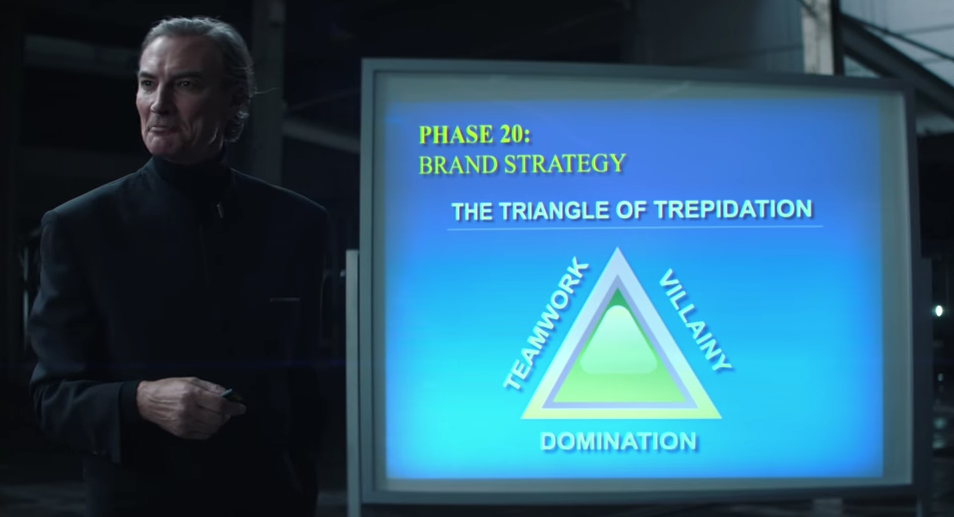Because (apparently), if we only had 15 more minutes, we could all save 15% or more on car insurance, GEICO has run a series of amusing TV commercials that imagine surreal sources of wasted time, including a Pictionary-playing sloth, Emperor penguins betrayed by faulty GPS, and an interstellar commander who loses his spaceship’s keys in the midst of an alien attack.
GEICO’s latest commercial takes aim at narcissistic supervillains: “As long as evil villains reveal their plans, you can count on GEICO saving folks money. Fifteen minutes could save you 15% or more on car insurance.” To be sure, GEICO is poking fun at the iconic villain trope that, by now, we all know gives our hero just enough time to save the planet. But in a comedic double whammy, GEICO puts in the villain’s hand the very weapon that, when inexpertly used, will undo his own evil plot: PowerPoint.
As the embedded video begins, a stereotypical Bond villain has our smartly-attired hero tied to a chair, threatening his demise. “Do your worst, doctor,” the hero goads, having no idea what the mad scientist has in mind. Emerging from the darkness, a disheveled assistant in Coke-bottle glasses – looking more Helpdesk than Igor – wheels into view with the instruments of torture: an oversized LED projector and slide show. The villain then takes the time to elaborate on his evil plot to take over the world.
“First, a little presentation,” the mad scientist begins, with an all too familiar click of his remote presenter. Slide One starts with “Hijacking earth’s geothermal energy supply,” the first phase of which critically depends upon “choosing the right drill bit.” Punctuated by overlong slides droning on about zoning difficulties and environmental study requirements (“huge headache,” the villain off-handedly confesses), our hero’s yawns signify a glacial passage of time perhaps even more deadly that the villain’s plan for world domination. Just as we are about to hear more about a slide that the villain likes to call “The Triangle of Trepidation,” GEICO’s ubiquitous announcer spares us with the catchline for this series of commercials. But saving money with GEICO isn’t all we can count on . . . .
The commercial’s resonance tells us that PowerPoint’s “weaponized” misuse is something else we can count on. It’s not only mad scientists and insurance commercials that help us understand why a great many PowerPoint presentations go wrong. So, although we’ve talked about this before, it may be a good time to refresh our thoughts on how to use this terrific tool in a manner that is effective and convincing – and that doesn’t feel like torture.
As we have said before in these pages, lawyers love words on slides, and some lawyers think that the more words they use in a PowerPoint litigation graphic, the better.
They are wrong. Actually, science has demonstrated that using too many words on a slide will dramatically damage your effectiveness as a trial lawyer.
This damage is not aesthetic in nature. This is not about the look and feel. It is about persuasiveness: the higher your slide's word count, the lower your persuasiveness. Take a minute to think about the best ad copy you’ve seen – is it wordy or succinct? Intricately complex, or pithy and simple?
At A2L, we see this every day. Sometimes a trial team may prepare their slides in draft form with paragraphs of text. Sometimes a trial team just converts their Microsoft Word outline into Microsoft PowerPoint. Sometimes a trial team edits the PowerPoint slides that we create by adding more words. We lawyers can be greedy; give us the real estate, and we’ll take it. But it really is true in this context that “less is more.”
There are many reasons lawyers abuse and overburden PowerPoint. Some lawyers mistakenly believe they are creating a record by including the text. That’s not true. The trial record is something entirely different – especially since these demonstrative aids are rarely admitted into evidence. Some lawyers want the text on screen so that they have notes to follow and can remember what to say. Some lawyers want to quote relevant text from documents in evidence. In just about every case, they are making a mistake.
If you are tempted to use PowerPoint as a substitute for careful thought, hard work or the use of precise language, just remember the “Triangle of Trepidation” and you will not go far wrong.
Other free A2L articles, webinars, and books about the use of PowerPoint, litigation graphics, and trial presentation generally:
- 16 PowerPoint Litigation Graphics You Won't Believe Are PowerPoint
- The 12 Worst PowerPoint Mistakes Litigators Make
- How Much Text on a PowerPoint Slide is Too Much?
- Connecting With Jurors by Turning Off Your Screen
- Lawyer Delivers Excellent PowerPoint Presentation
- 7 Ways to Avoid Making Your PowerPoint Slides Your Handout
- 12 Ways to Eliminate "But I Need Everything On That PowerPoint Slide"
- The Redundancy Effect, PowerPoint and Legal Graphics
- The Effective Use of PowerPoint Presentation During Opening Statement
- Don't Use PowerPoint as a Crutch in Trial or Anywhere
- How Much Text on a PowerPoint Slide is Too Much?
- How Many PowerPoint Slides Should You Use in a Typical Trial?
- The Redundancy Effect, PowerPoint and Legal Graphics
- 12 Things About PowerPoint You Probably Never Knew
- How to Make PowerPoint Trial Timelines Feel More Like a Long Document
- New Webinar - PowerPoint Litigation Graphics - Winning by Design
- Do Professionally Designed PowerPoint Slides Get Better Results?
- Why Reading Your Litigation PowerPoint Slides Hurts Jurors
- Why reading PowerPoint litigation graphics slides hurts your trial presentation's effectiveness
- Why shouldn't I just make my own PowerPoint slides?
- 16 Litigation Graphics Lessons for Mid-Sized Law Firms
- Free E-Book Download: Persuading with Litigation Graphics
- The 14 Most Preventable Trial Preparation Mistakes
- 12 Things About PowerPoint You Probably Never Knew
- 12 Reasons Bullet Points Are Bad (in Trial Graphics or Anywhere)
- The Effective Use of PowerPoint Presentation During Opening Statement
- 6 Studies That Support Litigation Graphics in Courtroom Presentations






Leave a Comment